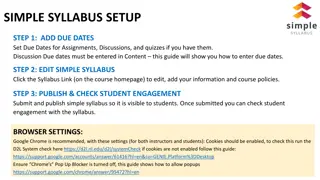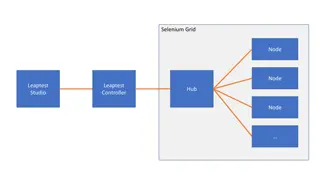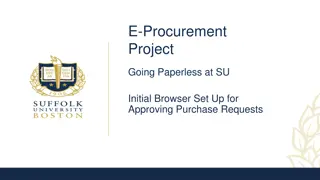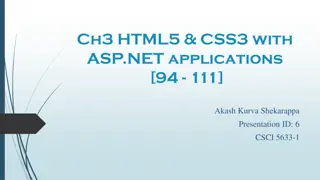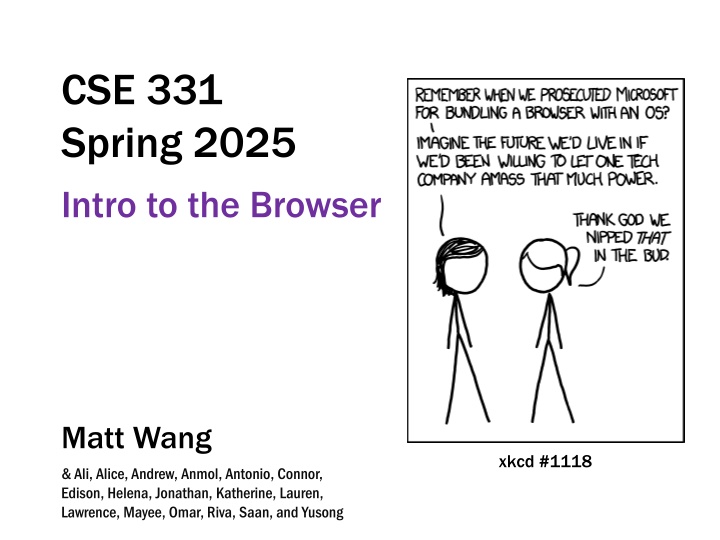
Browser Operation and Programming Models in Web Development
Understand the fundamentals of browser operations, server programming models, and client-server interactions in web development. Dive into concepts like the 123 Programming Model, server code behavior, and the role of HTML, CSS, and JavaScript in browsers. Explore the process of browsers fetching HTML content from servers and executing JavaScript to display web pages effectively.
Download Presentation

Please find below an Image/Link to download the presentation.
The content on the website is provided AS IS for your information and personal use only. It may not be sold, licensed, or shared on other websites without obtaining consent from the author. If you encounter any issues during the download, it is possible that the publisher has removed the file from their server.
You are allowed to download the files provided on this website for personal or commercial use, subject to the condition that they are used lawfully. All files are the property of their respective owners.
The content on the website is provided AS IS for your information and personal use only. It may not be sold, licensed, or shared on other websites without obtaining consent from the author.
E N D
Presentation Transcript
CSE 331 Spring 2025 Intro to the Browser Matt Wang xkcd #1118 & Ali, Alice, Andrew, Anmol, Antonio, Connor, Edison, Helena, Jonathan, Katherine, Lauren, Lawrence, Mayee, Omar, Riva, Saan, and Yusong
Notes on HW1 HW1 out! HW is mostly about debugging, not just coding so: we are mostly assessing you on debugging, and not really on correctness (see: spec!) but, you do need to attempt all functions advice: read spec carefully app is complex, but you are implementing a small subset you probably have questions about JS, node, NPM, and express. That s expected ask them! start early! & take advantage of office hours! 2
The 123 Programming Model Run code from front-to-back, once.* .java file (optionally) user input output (usually System.out) (optionally) loop until a condition is met 3
The 331 Server Programming Model Server Code runs forever! GET: /hi for each incoming request .js file server calls the route function, and sends a response response: { msg: "see saylaufey.com } infinite loop! 4
The 331 Programming Model, Zooming Out Client-Server programming has two programs request response (e.g., HTML) client server HW2 HW1 HW3 5
Recall: Browser Operation Browser reads the URL to find what HTML to load server name path Contacts the given server and asks for the given path request response (e.g., HTML) client server 7
Browsers: JavaScript and HTML request response (e.g., HTML) client server Browser natively knows how to display HTML Page can also include JavaScript to execute but it is not required if present, the JavaScript can change the HTML displayed 8
HTML HTML = Hyper Text Markup Language text format for describing a document / UI HTML describes the structure of the content, and (partially) what you want drawn in the browser HTML text consists primarily of tags and text 9
HTML Tags Element <p> Some Text </p> Content Tag Name Closing Tag Element <pid="firstParagraph"> Some Text </p> Attribute Value Content Tag Name Closing Tag Attribute Name 10
HTML as a Tree Elements can have children (text or elements) text is always a leaf in the tree <div> <pid="firstParagraph"> Some Text </p> <br> <div> <p>Hello</p> </div> </div> p div br div p 11
Parsing HTML HTML is a text format that describes a tree nodes are elements or text tree <div> <p>Some text</p> <p>More text</p> </div> div parse p p HTML text HTML tree HTML text is parsed into a tree ( DOM ) JS can access the tree in the variable document our code lives in the world on the right side 12
Displaying HTML Browser window displays an HTML document tree is turned into drawing in the page div Some text More text draw p p HTML display HTML tree browser displays the HTML in the window browsers parse and draw very quickly JS has limited access to display information 13
Developer Tools show the HTML Click on any HTML element and choose "Inspect" can see exact size in pixels, colors, etc. 14
Styling The style attribute controls appearance details margins, padding, width, fonts, etc. see an HTML reference for details (when necessary) Attribute value can include many properties each is name: value separate multiple using ; <p>Hi, <span style="color: red; margin-left: 15px">Bob</span>! </p> we will generally not worry much about looks in this class 15
Cascading Style Sheets (CSS) Commonly used styles can be named association of names to styles goes in a .css file // foo.css span.fancy { color: red; margin-left: 15px } // foo.html <p>Hi, <spanclass="fancy">Bob</span></p> Useful to avoid repetition of styling makes it easier to change 16
Including JavaScript in HTML Server usually sends back HTML to the browser Include code to execute inside of script tag: <script> console.log("Hi, browser"); </script> Can also put the script into another file: <scriptsrc="mycode.js"></script> 18
Events in the Browser Client applications are event-driven register "handlers" for various events Can do so like this in HTML (but don't!) <buttononClick="handleClick(event)">Click Me</button> <script> const handleClick = (evt) => { console.log("ouch"); }; </script> 19
Changing the HTML Change the HTML displayed like this (but don't!) <p>Add 2 to <inputtype="text" id="num"></input></p> <p><buttononClick="doAdd(event)">Submit</button></p> <div id="answer"></div> <script> const doAdd = (evt) => { const numElem = document.getElementById("num"); const num = Number(numElem.value); const ansElem = document.getElementById("answer"); ansElem.innerHTML = `The answer is ${num+2}`; }; </script> 20
Updating the DOM: Adding Nodes <h3>To-Do List</h3> <ulid="items"> <li>Laundry</li> <li>Wash Dog</li> </ul> ul li li li Laundry Lecture Wash Dog 21
Updating the DOM: Removing Nodes <h3>To-Do List</h3> <ulid="items"> <li>Laundry</li> <li>Wash Dog</li> <li>Lecture</li> </ul> ul li li li Laundry Lecture Wash Dog 22
Updating the DOM: Editing Nodes ul li li Laundry input Lecture 23
Problems with Old School UI Write code for every way the UI could change many, many cases particularly tricky when working in teams/groups Not specific to HTML same issue exists in Windows, on the iPhone, Xbox, etc. if you write code to put things on screen, then you write code to change where they are on screen 24
New School UI New approach: what should it look like now? write function that maps current state to desired HTML compare desired HTML to what is on the screen now make any changes needed to turn former into latter Huge improvement in productivity introduced in Meta's "React" library library performs the "compare" and "change" parts Faster to write HTML UI than anything else many similar libraries exist for the web same approach also used in mobile apps, games, 25
React we will use React in this class goal is not to make you React experts teach you just enough React to understand New School UI ideas these ideas will apply everywhere similar to JS & Express, only using small subset of the library practical note: React is a library installed with npm 26
HTML Literals in JSX JSX: extension of JS that allows HTML expressions file extension must be .jsx const x = <p>Hi there!</p>; 28
Substitution in JSX Supports substitution like `..` string literals, but uses {..} not ${..} const name = "Fred"; return <p>Hi {name}</p>; Can also substitute the value of an attribute: const rows = 3; return <textarearows={rows} cols="25"> initial text here </textarea>; 29
JSX Gotchas Must have a single root tag (i.e., must be a tree) e.g., cannot do this return <p>one</p><p>two</p>; instead, wrap in a <div> or just <>..</>( fragment ) Replacements for attributes matching keywords use className= instead of class= use htmlFor= instead of for= 30
CSS in JSX CSS styling can be used in JSX // foo.css span.fancy { color: red; margin-left: 15px } // foo.jsx import './foo.css'; // another weird import return <p>Hi, <spanclassName="fancy">Bob</span>!</p>; Nice to get this out of the source code 31
Anatomy of a React Component split up large web pages into individual components React components are classes class extends React s Component class has a constructor that takes in one argument (more on this in a moment) has a field called state (that holds the app s data/state) components should have a render method goal: convert app s state to JSX (which it returns) method should have be pure and have no side effects ; in other words, it should not change state we never call the render method React does for us 32
Simplest React Component Component that prints a Hello message: class HiElem extends Component { constructor(props) { super(props); this.state = {lang: "en"}; } render = () => { if (this.state.lang === "es") { return <p>Hola, Matt!</p>; } else { return <p>Hi, Matt!</p>; } }; } How do we change "lang"? 33
Simplest React Component (rendered) Hello Matt! Hola Matt! 34
Changing State in our Component render = () => { if (this.state.lang === "es") { return <p>Hola, Matt! <buttononClick={this.doEngClick}>Eng</button> </p>; } else { return <p>Hi, Matt! <buttononClick={this.doEspClick}>Esp</button> </p>; } }; doEspClick = (evt) => { this.setState({lang: "es"}; }; 35
React and Component State Changes <buttononClick={this.doEspClick}>Esp</button> doEspClick = (evt) => { this.setState({lang: "es"}; }; Must call setState to change the state directly modifying this.state is a (painful painful) bug React will automatically re-render when state changes but this does not happen instantly 36
React Responds to setState calls HTML on screen = render(this.state) Component React t = 10 this.state = s1 doc = HTML1 = render(s1) t = 20 this.setState(s2) this.state = s2 doc HTML2 = render(s2) t = 30 React updates this.state to s2 and doc to HTML2simultaneously 37
React Component with an Event Handler Pass method to be called as argument (a callback ): <buttononClick={this.doEspClick}>Esp</button> Be careful not to do this: <buttononClick={this.doEspClick()}>Esp</button> Including parentheses here is a bug! that would call the method inside render passing its return value as the value of the onClick attribute we want to pass the method to the button, and have it called when the click occurs 38
Putting the UI in the Page Initial page has a placeholder in the HTML: <divid="main"></div> (empty DIV in index.html) Put HTML into it from code like this: const elem = document.getElementById("main"); const root = createRoot(elem); root.render(<HiElem />); createRoot is a function provided by the React library tells React that it should keep the HTML in the page matching what render returns 39
Putting the UI in the Page: Props Initial page has a placeholder in the HTML: <divid="main"></div> (empty DIV in index.html) Put HTML into it from code like this: const elem = document.getElementById("main"); const root = createRoot(elem); root.render(<HiElemname={"Matt"} size={3}/>); in HiElem, this.props will be {name: "Matt", size: 3} each component is a custom tag with its own attributes ("properties") 40
Props and State, Together render = () => { if (this.state.lang === "es") { return <p>Hola, {this.props.name}! <buttononClick={this.doEngClick}>Eng</button> </p>; } }; render can use both this.props and this.state difference 1: caller give us props, but we set our state difference 2: we can change our state 41
CSE 331 Spring 2025 More React Matt Wang xkcd #1118 & Ali, Alice, Andrew, Anmol, Antonio, Connor, Edison, Helena, Jonathan, Katherine, Lauren, Lawrence, Mayee, Omar, Riva, Saan, and Yusong
The Old School UI model (1/2) Hello Matt Espa ol 43
The Old School UI model (2/2) State is stored in the DOM / HTML. Hola Matt Works for small examples, breaks with complex apps English 44
The React Model (1/3) Hello Matt { lang: "en" } Espa ol button click triggers an event 45
The React Model (2/3) eventually, React re-renders state is updated Hello Matt { lang: "es" } Espa ol button click triggers an event 46
The React Model (3/3) eventually, React re-renders state is updated Hola Matt { lang: "es" } English button click triggers an event 47
Reactive UIs, more generally (re-)renders the actual web page (the DOM, browser, or view ) the app s state events you only have to write event handlers & render function but, you have to play by the rules, or new bugs!! view must be a function of just the app state render mustbe pure (no side effects!) 48
Reminder: React in Practice Writing User Interface with React: write a class that extends Component implement the render method Each component becomes a new HTML tag: root.render(<HiElemname={"Matt"}/>); in HiElem, this.props will be {name: "Matt"} Can use props and state (and only those!) in render: render = () => { if (this.state.lang === "en") { return <p>Hi, {this.props.name}! <buttononClick={this.doEspClick}>Esp</button> </p>; 49
Second React Component: More User Input Put name in state and let the user change it: class HiElem extends Component { constructor(props) { super(props); this.state = {name: "Matt"}; } render = () => { return <p>Hi, {this.state.name}</p>; }; } How do we change the name? Ask the user for their name. 50

